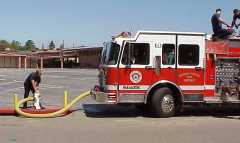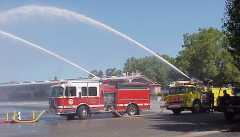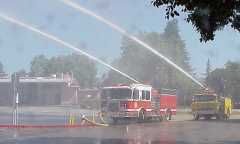- The first arriving engine makes a standard steamer hookup to the
hydrant.
- The first arriving engine fulfills its tactical objectives.
- The second arriving engine takes a position and makes a LDH suction
hookup to a LDH suction connection on the first engine.
(The first engine's suction piping acts as a manifold and all water not
taken by the first engine's pump is available to the second engine at
hydrant pressure.)
- The second arriving engine fulfills its tactical objectives.
- If the residual pressure coming in to the second engine falls off
too sharply (approaches or drops below 10 p.s.i.) a second supply line
should be connected from the hydrant's 2½" outlet to a gated LDH or pony suction
connection on the second engine.
(Where practical, a 50 ft. section of LDH can be used to provide the
second line and will have greater hydraulic efficiency.)
Trial Results:
The first arriving engine had no difficulty maintaining residual pressure.
The second arriving engine dropped below 10 p.s.i. residual pressure but
this weakness would be adequately corrected by adding the second hydrant supply line.
Key Points:
It would be a rare occurrence for two engines to each flow 1000 GPM during a
two pumper hookup, however we know that it can be done.
A backup hydrant supply line should be connected beweeen an unused hydrant outlet to the second engine.
Engineers should communicate with each other when significant flow changes take
place.
|
First engine makes a steamer hookup

Second engine hooks to LDH suction on first

View of the dual pumping operation

2000 GPM combined flow

|



